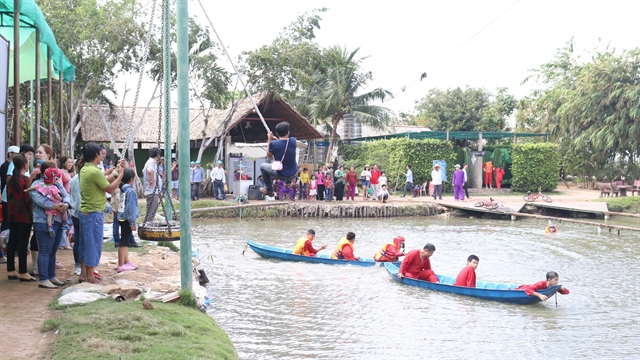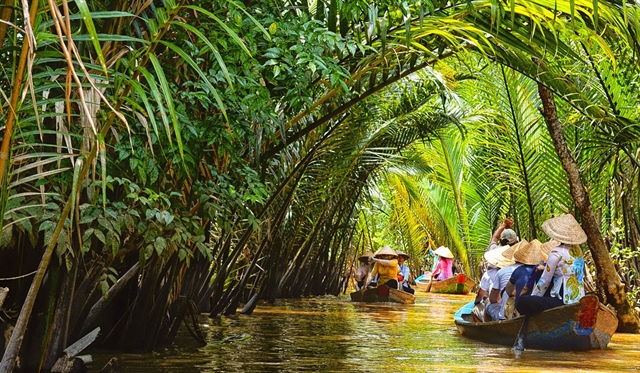 |
| Nguyễn Thị Ngọc Nhiên, marketing manager of Cồn Phụng Tourist Area in Bến Tre Province. VNS Photo Văn Châu |
Sustainable development of green tourism associated with culture, history and tradition in Mekong Delta provinces is a new trend in the tourism industry.
However, investors face multiple obstacles in investing and developing green tourism.
Việt Nam News speaks with Nguyễn Thị Ngọc Nhiên, marketing manager of Cồn Phụng Tourist Area in Bến Tre Province, one of the top green tourist destinations in the delta.
What potential and opportunities do the Mekong Delta provinces have to sustainably develop green tourism associated with cultural identity, historical and traditional heritage?
The Mekong Delta is the third largest delta formed by the world's tenth longest river, the legendary Mekong.
The Mekong Delta has a diverse and unique ecosystem, from marine ecosystems, islands, estuaries, wetlands, mangrove forests and delta islands, with many biosphere reserves, national parks and nature reserves with high biodiversity.
This region features beautiful sites, such as Mũi Cà Mau National Park and U Minh Hạ (Cà Mau Province), U Minh Thượng (Kiên Giang), Tràm Chim National Park (Đồng Tháp), Phú Quốc Island (Kiên Giang) and Bạc Liêu Bird Sanctuary (Bạc Liêu).
These are very valuable resources for ecotourism development.
In addition, the region also has more than 700km of coastline, more than 145 large and small islands and many beautiful, pristine beaches such as Mũi Nai, Hòn Chồng (Kiên Giang), Hòn Khoai (Cà Mau) and Ba Động (Trà Vinh).
The advantages of rich natural resources, combined with the quintessence of culture and history, have given the Mekong Delta endless potential for developing ecotourism and resorts.
The delta also has the potential to develop diverse and rich tourism such as garden ecotourism, river tourism, sea and island tourism, indigenous culture tourism and spirituality.
However, tourism businesses are still facing many difficulties in effectively exploiting the potential to develop sustainable green tourism.
What are the difficulties, if any, when businesses invest in green tourism?
Green tourism is a type of tourism that operates in a way that minimises environmental impact, actively contributes to biodiversity protection, uses renewable energy, promotes natural and cultural heritage, and develops environmentally friendly products.
Therefore, the cost of construction investment, application of environmentally friendly technologies and maintenance fees are very large.
Some investors are converting traditional tourism models to green tourism but still encounter multiple difficulties such as recognising the importance of environmental protection, training staff and building green tourism products.
On the other hand, infrastructure and transport to places with potential for tourism development are not yet compatible and do not meet the requirements for green tourism development.
There are currently no green tourism criteria available to apply nationwide and businesses also face multiple difficulties in financial resources for conversion.
Therefore, many businesses believe that there should be a priority program to support businesses and travel agencies in developing green tourism in terms of capital, knowledge, improving tourism capacity and encouraging training of tourism human resources for this field.
 |
| Tourists participate in traditional games at Cồn Phụng Tourist Area in Bến Tre Province. VNS Photo Văn Châu |
What support do businesses need from the government to develop green tourism?
The government should introduce specific policies and regulations to encourage and support tourism businesses in transitioning to a green tourism model. This could include tax incentives, financial support, and training programmes on sustainable tourism.
To make the populace aware of green tourism, the government needs to increase education and awareness through publicity campaigns and training programmes.
Raising awareness of the importance of environmental and resource protection will promote customer choice and community support.
To build public awareness and interest in green tourism, governments at all levels and businesses need to increase information and communication about the benefits and value of sustainable tourism.
Using media channels, social networks, websites and publicity campaigns will help spread the message of green tourism, encouraging people to participate in environmentally responsible tourism activities.
In addition, local governments need to create a favourable environment for tourism businesses and non-governmental organisations to cooperate in developing green tourism.
This cooperation can include sharing knowledge and experience, developing joint projects and programmes, and creating financial mechanisms to support green tourism projects.
To develop green tourism, governments and businesses need to cooperate to invest in green infrastructure and technology. Using renewable energy, building smart water treatment systems, and applying energy-saving technology in hotels, resorts, and transport will reduce the impact on the environment and resources.
Local authorities should also organise more international conferences in the field of green tourism as a way to create innovation and promote the development of the tourism industry.
Learning from countries that have succeeded in green tourism and establishing international links will bring great benefits to Việt Nam in general as well as the Mekong Delta in particular, and contribute to the sustainable development of green tourism.
Creating diverse and attractive green tourism products also plays a key role in the green tourism development.
 |
| Mekong Delta provinces need to develop their own unique tourism products to develop sustainable green tourism. VNS Photo Văn Châu |
What green tourism products does the Mekong Delta need to attract investors as well as tourists?
In order for green tourism in the Mekong Delta to have a breakthrough in development commensurate with the great potential and advantages of the region, promoting connections to form new, attractive, and unique tours, routes, and tourism products is the direction that needs to be given top priority.
Recently, Mekong Delta provinces have agreed to cooperate in tourism with HCM City, and many linked products have been born, such as "Alluvial Roads" connecting HCM City-Tiền Giang-Vĩnh Long-Cần Thơ-Hậu Giang-Sóc Trăng-Bạc Liêu-Cà Mau, "Lovely Mountains and Rivers" connecting HCM City-Tiền Giang-Bến Tre-Trà Vinh or "Colours of the Border Region" connecting HCM City-Long An-Đồng Tháp-An Giang-Kiên Giang.
From these new tourism products, about 80 linked tourism programmes have been exploited by travel companies, contributing to a strong recovery for tourism in the delta after the COVID-19 pandemic.
It was reported that in 2023, nearly 45 million visitors came to Mekong Delta provinces, an increase of 20.4 per cent over the previous year. International visitors reached more than 1.8 million, up by more than three times, with revenue reaching nearly VNĐ46 trillion (US$1.91 billion), an increase of 42.6 per cent over the same period.
However, the potential of regional tourism has not been effectively exploited due to unprofessional methods, inadequate human resources, and limited tourism infrastructure.
Some regional tourism products are not really attractive and lack competitiveness.
Therefore, building regional tourism products has become an issue of concern for many localities.
Identifying tourism products is the key factor that makes the difference, with each locality gradually planning and building its own products. VNS


